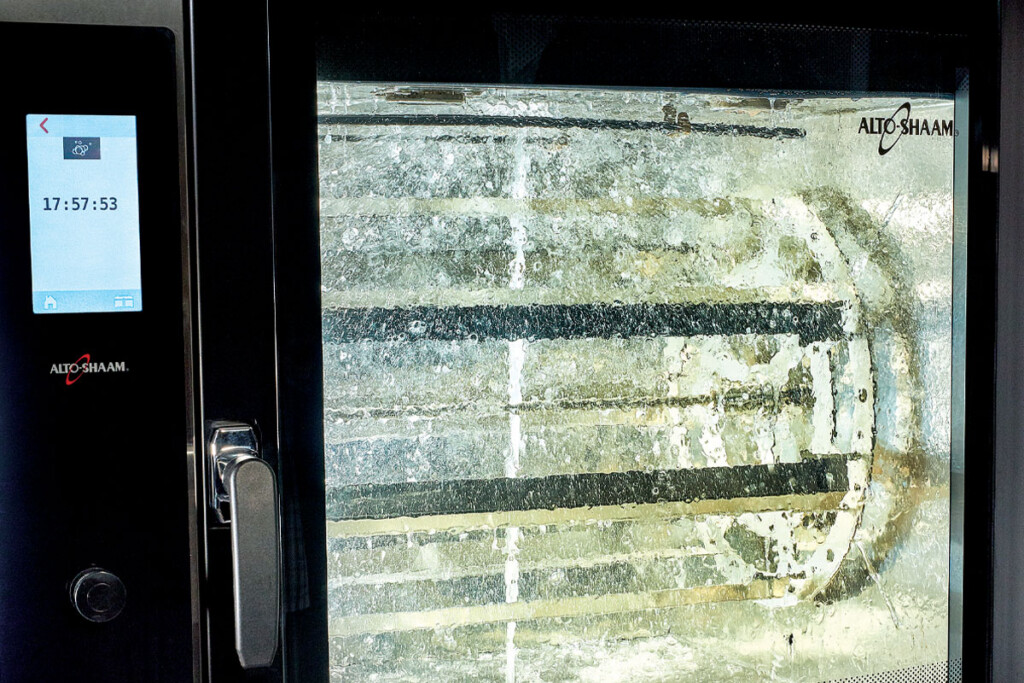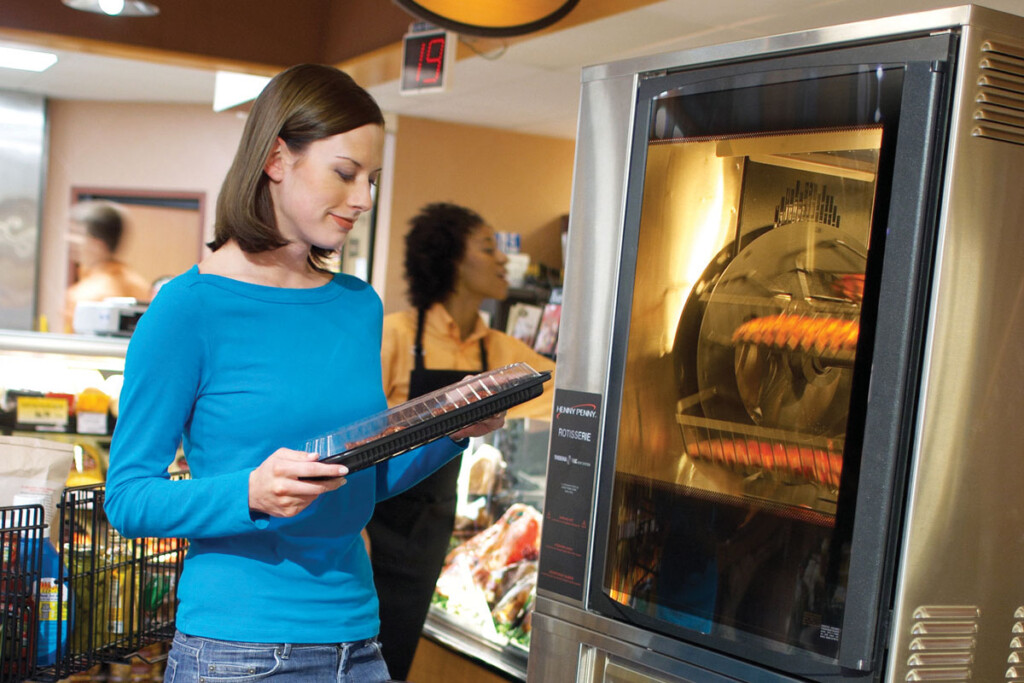Rotisserie ovens can help present food as theater, serving as a warm, welcoming and well-lit stage for the stars of the show, from whole chickens to ribs, roasts, pork loin and even vegetables and pastries. With their glass fronts, rotisseries put food on display and merchandise it as it cooks—even if customers are simply picking up a to-go order versus dining in. But in some instances, operators prefer to place rotisseries out of sight in the back-of-house to block views of messy raw protein production. Situated front and center or in the back, the latest rotisserie ovens come in many sizes and styles to accommodate virtually any operation—from convenience stores to high-volume chains.
Models range in size from compact countertop units up to large floor models, and they can cook from about eight to 80 birds at a time. (Though rotisseries can cook a wide range of products, they’re still used primarily for chickens, which is how most manufacturers rate capacity, rather than by weight.) Which model you choose depends on your volume, the products you want to cook and your concept. At their most simple, rotisserie ovens use a combination of radiant heat—whether from a gas infrared burner, electric quartz or metal element, or wood or gas flames—and convection heat. The radiant heat browns the meat, poultry or other foods while the convection heat slow roasts it. Many models have enough bells, whistles and digital brains to cook anything on your menu.
In general, rotisseries come in two different types, continuous and batch. As the names imply, one lets employees load product and unload it as it’s done; the other cooks a batch of product all at once and employees unload it when the batch is done. Continuous rotisseries tend to be larger and can be real show-stoppers visually; batch models offer more control and often faster cooking.
Continuous rotisseries—often seen in restaurants or supermarket delis that highlight roasted meats—have anywhere from two to eight horizontal spits arranged one above the next in a vertical cabinet. On the back of the cabinet, behind each spit, is a radiant heat element that also provides convection heat. Employees can adjust the heat for each individual element, typically with low, medium and high settings. Some models have gas flame burners either at the base or behind each spit for visual appeal and additional heat, or space in the base for a wood-burning hearth.
A chain drive on some models connects the spits to a motor, which rotates the spits from about 3 to 6 rpm. Other models feature individual motors and a gear drive for each spit that allow employees to adjust the rotation speed for the food being cooked.
Cabinets aren’t very deep—typically 18 to 25 inches—but they can be about 40 to 90 inches wide. Countertop models are about 38 inches high, but floor models can range to above 6 ft. tall.
Because of their design, continuous rotisseries require more of a hands-on cooking experience than batch ovens. Heat from the radiant elements rises in the cabinet, so food on the top spits tends to cook a little faster than items on the bottom. Makers usually recommend loading from the top spit down, and when product on the top spit is done, removing it and moving all spits up one position to make sure raw product is on the bottom and doesn’t contaminate cooked food. Some models have two separate cooking chambers with separate controls to give you greater flexibility, such as roasting meats in one chamber and vegetables in the other.
Benefits of Using a Rotisserie Oven: Even Cooking: Rotisserie cooking ensures that food cooks evenly on all sides, resulting in tender, juicy meats with a crispy, golden exterior. Flavorful Results: Cooking food on a rotating spit allows it to baste in its own juices, enhancing its flavor and moisture content.

One Batch at a Time
Batch rotisserie oven design locates the spits on a revolving drum. The spits themselves are stationary on many models. Radiant elements are located in the cabinet in such a way that all surfaces of the food are exposed at some point to ensure even browning. On some other models, spits rotate as many as 61/2 times per drum revolution, using a planetary gear mechanism, again ensuring that food browns evenly. Keep in mind that sometimes more moving parts means more service; check service records on the models you’re considering. Most batch models use an electric or gas burner to add convection heat to the entire cabinet. Employees can control the convection heat and radiant heat elements separately to ensure even cooking inside and out. Several models allow employees to program cooking cycles based on the product being roasted.
The idea behind adding a convection heat source in batch rotisseries to the radiant heat source is to speed throughput. Where cook time on chickens might be 90 minutes in a continuous rotisserie oven, for example, batch rotisseries aim to cut that to 60 to 75 minutes depending on the bird’s size and weight. And what some manufacturers have done in recent years is add moisture to the cabinet and programmability, essentially making these rotisseries mimic combi ovens, able to cook an even wider range of foods to perfection in a shorter time.
Footprints of batch units tend to be boxier—deeper, but not as wide—than continuous rotisseries. Like continuous models, they’re available in countertop and floor models; however, you can stack them because of their shape and size, giving you the same capacity as a large continuous rotisserie—about 80 birds.

The production capacity you specify obviously depends on your sales volume, and as a general rule you should add an additional 15% capacity to accommodate growth. If, for example, during your biggest rush you sell 40 chickens per hour, you’ll need a rotisserie capable of cooking about 46 birds in 60 minutes.
But you may want to consider other factors. Energy use is one. If your volume at other times isn’t close to what you sell during a rush, you may want to have two rotisseries and keep one off or idling in nonpeak hours, versus powering one larger unit all day. Your menu is another factor. If you want more menu flexibility, or if you already sell more rotisserie items than just chicken, multiple rotisseries will give you the ability to expand your menu more easily and still meet production demand.
Also take labor into consideration. You may have demand for enough product to use 5-ft. spits, but they usually require two people to load and unload. A unit with 3-ft. spits that one person can handle may be better suited to your operation. Likewise, if staff isn’t trained to operate a continuous rotisserie, a programmable batch oven could be a better fit.
Last, but not least, find space to load and unload spits, and purchase holding cabinets for cooked product. Some rotisserie models are available with matching merchandising hot cases.

There are a few things you should know about utilities before you decide what model to specify.
Gas pressure should be adequate as some gas rotisseries will burn 195,000 Btu/hr. or more. Some makers have incorporated high-efficiency burners that can save 30%-35% in energy cost.
High-amperage circuits are typically required for electric rotisseries. You can spec 208V, 220V, 240V or even 400V service. A 208V single-phase unit may draw 53.4 amps while the same unit in 208V three-phase draws 33.6 amps, and a 400V three-phase unit draws 18.3 amps. Make sure you match the electric service coming into your store.
Motors and lights require an electric hookup, of course, even if you’re using a gas unit. Again, make sure you have the right service—and circuit—at the location you intend to place the unit.
Plumbing also needs to be routed to the place you intend to put the rotisserie if it requires a water hookup, as many batch rotisseries do. For those with an automated wash cycle, you’ll also need a drain. Continuous rotisseries don’t require plumbing; they usually have a pan in the base you fill with water that serves a dual purpose—it provides moisture in the cooking cabinet, and serves as a catch basin for grease.
Ventilation hoods are required for gas-fired equipment, but may not be needed for an electric rotisserie depending on what you’re cooking. If your local fire code requires a hood over electric models, some are available with ventless hood options.
Wood can be used in certain gas-assisted rotisseries to impart some smoke flavor to roasting foods.
5 Best Countertop Rotisserie Oven
FAQ
Are rotisseries worth it?
Is it worth getting an air fryer with a rotisserie?
Is rotisserie better than roasting?
Should you buy a rotisserie or Roaster Oven?
If you’re a home cook who spends a lot of time cooking meat, a countertop rotisserie or roaster oven could be a great appliance for your kitchen. The beauty of a rotating rotisserie is the meat self-bastes as it turns in the oven, ensuring even cooking. It allows cooks of all levels to make the richest, most succulent meat.
How to choose a rotisserie oven?
If you have limited counter space, opt for a vertical unit like Nutrichef Upgraded Multi-Function Rotisserie Oven. A taller oven has a smaller footprint, which saves on counter space. However, a vertical oven is reported to result in dryer meat than its horizontal counterpart – so select wisely. While at it, consider your workflow arrangement!
Why should you buy a rotisserie oven?
The oven crisps your meals to perfection with little to no oil. With it, you get to experience different flavors with the touch of a button. After all, the preset smart programs help you to easily bake, broil, reheat, roast, air fry, dehydrate, cook, or proof dough on a rotisserie. Imagine making juicy chicken wings, onion rings, and crispy fries.
How much does a rotisserie oven cost?
Rotisserie ovens’ costs range between $100 and $200. Larger models and popular brands are often pricier. At such price tags, it’s paramount to opt for a model that is not only durable but one with a significant warranty period. Think of 6 months and above.
